Performance, design, user experience, and many other things might be among the objectives of your web development project.
Therefore, the question is not which of the various web technologies on the market is best, but rather which one best suits the needs of your website.
The best web technologies for your business have been covered in this article.
The Best Technologies For Web Development In 2023
For the most part, client-side and server-side coding, scripting, and programming are used to create web apps.
Table of Contents
ToggleTechnologies for client-side web development
Browsers comprehend a certain type of code known as client-side coding. Typically, any website visitor has access to view it.
Standard client-side scripting technologies include some of the following:
1. HTML: It serves as the default markup language for files intended to be viewed in a web browser.
2. CSS: It is a markup language style sheet language that describes how a document is presented. Additionally, it makes it possible to separate content from presentation, including fonts, colors, and layouts.
3. JavaScript: It is a small, loosely typed language that is typically used by web developers. Because more new frameworks and best practices have emerged in recent years, it now supports client-side interactivity and is extensively used.
4. AJAX: It is a collection of web development methods for building asynchronous web apps using different client-side web development tools.
5. jQuery: It is a JavaScript library that makes traversing and manipulating the HTML DOM tree simpler. Additionally, it makes event handling, CSS animation, and AJAX simpler.
6. MooTools: A simple, open-source, object-oriented JavaScript framework is called MooTools (or My Object-Oriented Tools). This framework has built-in tools for working with JavaScript objects, AJAX queries, DOM components, CSS, and more.
7. Dojo Toolkit: This is a modular open-source JavaScript toolkit made to speed up cross-platform development. It is a JavaScript framework designed to address all of the diverse requirements of extensive client-side web development.
Technologies for Server-Side Web Development
The kind of code that is interpreted by the web server is known as server-side scripting. Any visitor cannot access or see it.
1. PHP: It is a well-known, open-source, and cost-free scripting language. The PHP code is run on the server, and the browser receives the output as plain HTML.
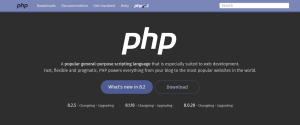
2. Zend Framework: It is a collection of expert PHP packages that are now known as Laminas and are included in PHP7. It is an open-source framework for object-oriented web applications.
3. ASP.NET: This open-source framework for server-side web applications was created for web developers to create dynamic websites.
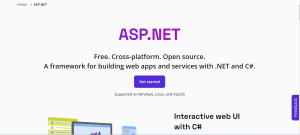
4. ColdFusion: It is the enterprise-level quick web application development platform from Adobe. Initially, it was created to make it simpler to connect straightforward HTML pages to the database.
5. Ruby on Rails: Ruby is used to creating this framework for server-side web applications. A database, a web service, and web pages all have default structures thanks to the MVC (Model-View-Controller) framework.
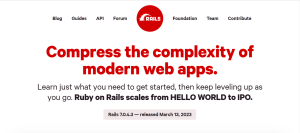
6. Python: This is a high-level, general-purpose programming language that supports several object-oriented, functional, and structured programming paradigms.
7. Perl: Text manipulation was the initial goal of this all-purpose programming language’s creation. It is presently utilized for a variety of activities, including GUI creation, web development, and system administration.
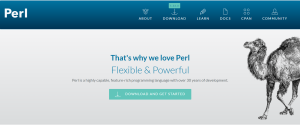
All the aforementioned technologies can be used by a dedicated web development company. You can evaluate your needs and financial constraints to find the best value for your website development project.
Frequently Used Web Development Frameworks
A web application framework provides a wide variety of pre-written components and code snippets. These frameworks can boost your productivity while also reducing the amount of code you write.
Frameworks for client-side web development
1. Ember: It is a JavaScript framework that is open-source that enables developers to build scalable single-page web apps. It is an older framework with fewer users, but because of its stability, community support, and coding standards, it is still rather popular.
2. Angular: It is an open-source framework for web applications that are managed by the Google Angular team. Declarative HTML templates are used in this framework, which is built on components.
3. Vue: It is a free and open-source model-view JavaScript framework for creating single-page apps and user interfaces.
4. React: Based on UI components, this free and open-source front-end JavaScript library creates user interfaces. React can be used as a building block for single-page or mobile applications.
Frameworks for server-side web development
1. Django: A high-level Python web framework, it fosters quick development and clear, practical design. Its code is simple to read and maintain because it is based on Python. Additionally, it is quick, safe, and scalable.
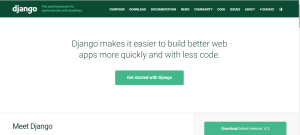
2. Flask: It is described as a Python-based microweb framework. It falls within the microframework category because it doesn’t require any special libraries or tools. Extensions that can incorporate Flask-implemented application functionality are supported.
3. Laravel: It is a framework for web applications with an attractive and expressive syntax. This PHP framework is free and open source, and it is reliable. It incorporates the essential components of PHP frameworks like CodeIgniter and others and makes use of the MVC design pattern. If you are comfortable with PHP, Laravel will simplify your process.
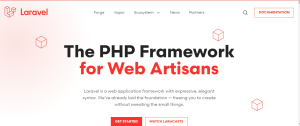
Popular Web Components and Related Development Technologies
API-First approach
The API-First approach to web development is currently popular. By enabling web developers to reuse the same code across projects, it helps to lower the development cost. An API sends user queries to a system, which then responds appropriately.
Motion UI
It is a library with a large selection of eye-catching animations and the most recent front-end technology. Many websites rely on entertaining animations to gain popularity. Fun animations make the material more interesting, which encourages people to return to these websites frequently to view the fun animations.
Motion UI enables website designers to include these entertaining animations to leave a lasting impression on the user. Additionally, it enables the designers to create original animations.
Voice Search Improvements
Companies like Amazon and Google are attempting to improve the UI as voice search gains in popularity. In contrast to voice search, which allows users to simply ask a question as they would with a human, the browser will then display the results, while users of standard web search are compelled to enter and access a web page.
IoT (Internet of Things)
It is the ability of gadgets to communicate with one another over the internet. IoT systems work with enormous amounts of data that are gathered from sensors, processed, and sent to cloud servers. After that, cloud servers examine this data and recommend the appropriate course of action.
It aids in creating a completely interconnected world for web developers. Faster device connectivity is established, which leads to better online solutions.
Artificial Intelligence and Bots
AI systems analyze data like search history, purchase history, number of website visits, and many other variables to identify client behavior.
Chatbots using AI facilitate conversation. These chatbots are extremely useful because they interact with the user like a human executive and address problems.
AI aims to make navigating simple and offer the user the ideal browsing experience.
PWAs (Progressive Web Applications)
These are web applications that resemble native mobile apps in both appearance and functionality. PWAs can be used offline, which is a big advantage for people who don’t always have access to high-speed internet.
Its development is less difficult than that of native programs. PWAs also load faster, so even during periods of high web traffic, consumers won’t have to wait long for the website to load.
Serverless Applications
Webmasters can build, maintain, and operate websites using serverless architecture without spending money on server infrastructure. It will make it possible for websites to run their programs on constantly switching servers using cloud-based resources. By consuming less hardware over time, it helps the website save money by enabling efficient hardware usage.
Conclusion
As we wrap up this discussion, it’s important to remember that every framework has special features and capabilities that help developers and development projects perform better. The technologies, frameworks, and trends covered in this essay will undoubtedly change the game, but only if they are applied correctly.
